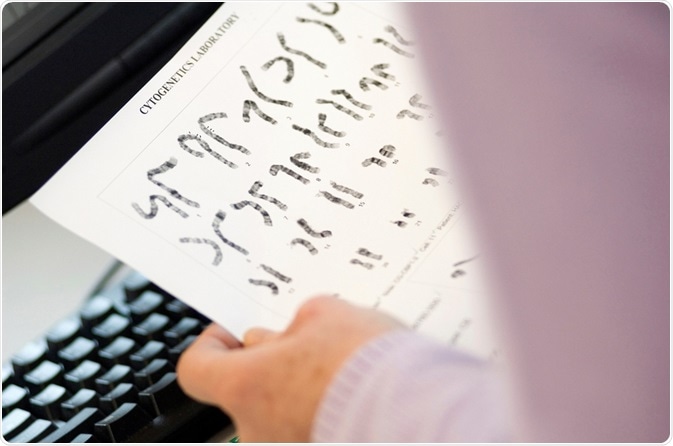What is flow cytometry?
Flow cytometry can be used to measure a number of characteristics of a population of cells and refers to the process of passing cells individually through a single or series of laser beams adjacent to a number of detectors.
The way in which the light is scattered and disrupted by the passage of the cell can be used to infer information regarding the size, composition, and morphology of the cell, and the technique can additionally be combined with fluorescence microscopy to identify the presence and quantity of specific structural features that have been tagged with a fluorophore.
The technique is used in the diagnosis of a number of diseases, as cells sourced from patient biopsy samples can be labeled with indicative biomarkers and processed in a sensitive high-throughput manner.
.jpg) Image Credit: mh_enders / Shutterstock.com
Image Credit: mh_enders / Shutterstock.com
What is cytogenetics?
Cytogenetics is the examination of the structure of the chromosomes by fixing and staining, revealing the structural details of packed DNA and how they relate to cell behavior. A number of staining techniques can be used to highlight the regions of interest, and individual genes can be labeled using highly specific fluorophore tags.
This allows aberrations in the genome to be detected, known as a clonal abnormality, and so the technique is used in the diagnosis and prognosis of some cancers to determine the genes that may have been lost or added in error. Cytogenetic studies may take a multitude of forms and employ a wide variety of analytical methodology and equipment, as any study of the genetics of the cell could fall under this category.
In particular, however, the technique referred historically to the use of simple staining techniques that allowed one to view chromosomes through light microscopes and therefore identify any structural anomalies, though advances in biochemistry have evolved the field into what is often termed “molecular cytogenics”.
 Image Credit: RHIMAGE / Shutterstock.com
Image Credit: RHIMAGE / Shutterstock.com
How can the techniques be combined?
The techniques complement each other in the diagnosis of a number of disorders, allowing researchers and clinicians to identify the presence of key biomarkers associated with disease.
Gomyo et al. (2003) assessed the usefulness of each technique individually in detecting bone marrow involvement in B-cell lymphoma cases. Flow cytometry was able to correctly identify bone marrow involvement in all but one case, though also had a small number of false-positives.
Cytogenetics was only able to reveal monoclonal abnormalities in a small number of cases, suggesting flow cytometry to be superior in terms of sensitivity. However, the authors note that some of the cases identified by cytogenetics could only have been revealed by that method, entailing complex structural chromosomal abnormalities.
Many immune disorders are diagnosed by a combination of flow cytometry and cytogenetics, with the latter being the ultimate genetic confirmation, while flow cytometry offers fast and reliable evaluation of cell populations and sub-populations. Clusters of differentiation are highly specific sites on the surface of cells that are recognized by one or multiple antibodies, and these sites can be exploited to fluorescently tag the lymphocytes of sample serum collected from a patient.
The high density of the clusters of differentiation on the cell surface makes distinguishing the cells by flow cytometry simple, and the relative proportions of each type of lymphocyte can provide revealing information regarding patient diagnosis and prognosis.
Importantly, the techniques may be more directly combined by firstly staining the chromosome of the cell of interest and then passing the cell population through a flow cytometer. This allows the cells to be sorted by the equipment based on the detection of chromosomal abnormalities or specific genes, based on the detection of light emitted by fluorophores bound to these structural features.
However, in many cases, this technique is largely limited to detecting the quantity of DNA in a cell, as the signal produced by fluorophores on the few copies of the target DNA sequence per cell are not intense enough to be detectable by flow cytometry.
Many researchers are working towards the detection of single-copy DNA by flow cytometry by incorporating signal amplification technologies such as fluorescence in-situ hybridization (FISH). This would allow the fast and reliable sorting of cells with highly specific gene mutations, and be invaluable to the bioscience field.
While flow cytometry is fast and reliable, full cytogenetic evaluation reveals prognostic information regarding the likely future progression of a disease that cannot be gained from flow cytometry alone. Therefore, the techniques are often used in combination for full diagnosis and prognosis of a disorder.
Source
McKinnon, K. M. (2018) Flow Cytometry: An Overview. Current Protocols in Immunology, 120. https://www.ncbi.nlm.nih.gov/pmc/articles/PMC5939936/
Hamerton, J. L. (2013) Human Cytogenetics: Clinical Cytogenetics. books.google.co.uk/books
Gomyo, H. et al. (2003) Morphologic, flow cytometric and cytogenetic evaluation of bone marrow involvement in B-cell lymphoma. Haematologica, 88(12). https://pubmed.ncbi.nlm.nih.gov/14687988/
Rabinovitch, P. S. et al. (1981) Flow-cytogenetics. Cytogentic Cell Genetics, 29. https://www.karger.com/Article/Abstract/131553
Vidrales, M., et al. (2016) Minimal residual disease evaluation by flow cytometry is a complementary tool to cytogenetics for treatment decisions in acute myeloid leukaemia. Leukemia Research, 40. www.sciencedirect.com/.../S0145212615303945
Uno, N., et al. (2020) Flow cytometry assay for the detection of single-copy DNA in human lymphocytes. Nucleic Acids Research, 48(15). https://academic.oup.com/nar/article/48/15/e86/5858117
Kanegane, H. et al. (2018) Flow cytometry-based diagnosis of primary immunodeficiency diseases. Allergology International, 67(1). https://www.sciencedirect.com/science/article/pii/S1323893017300679
Last Updated: Jan 12, 2021